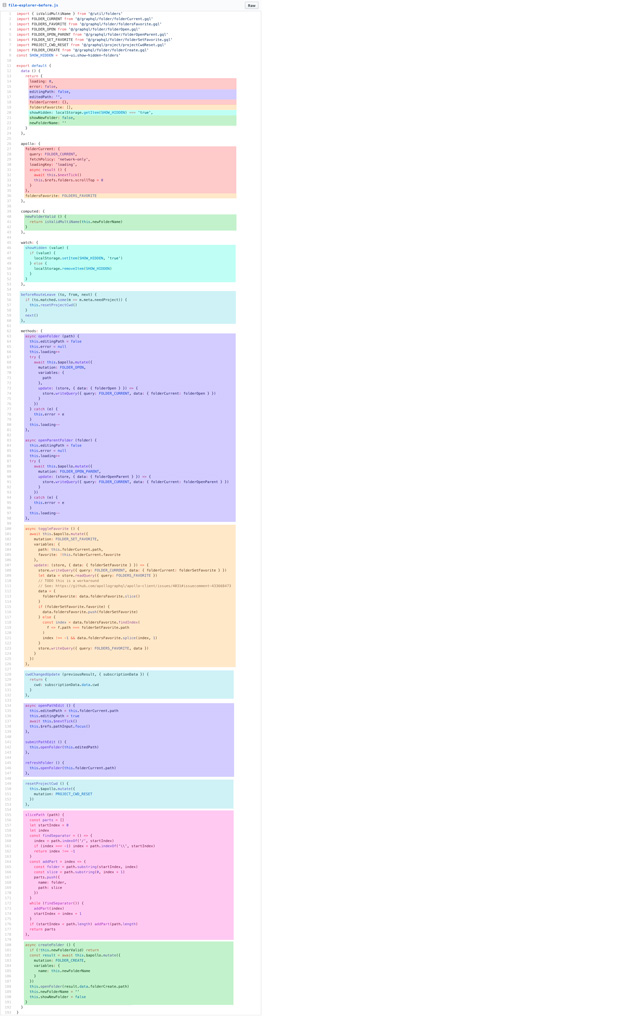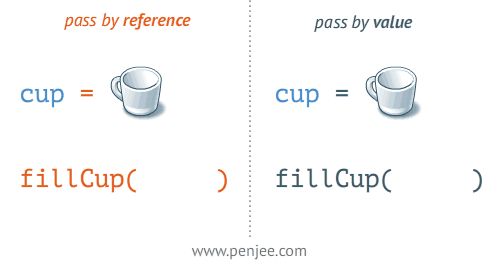您好,登录后才能下订单哦!
这篇“Vue组合式API源码分析”文章的知识点大部分人都不太理解,所以小编给大家总结了以下内容,内容详细,步骤清晰,具有一定的借鉴价值,希望大家阅读完这篇文章能有所收获,下面我们一起来看看这篇“Vue组合式API源码分析”文章吧。
在前面的课程中,我们都是采用 Options API(基于选项的 API ) 来写一个组件的。下面是一个实例:
<template>
Count is: {{ count }}, doubleCount is: {{ doubleCount }}
<button @click="add">加</button>
</template>
<script>
export default {
data() {
return {
count: 0,
};
},
computed: {
doubleCount() {
return this.count * 2;
},
},
methods: {
add() {
this.count++;
}
}
}
</script>当要去理解一个组件时,我们更加关心的是:“这个组件是要干什么(即代码背后的意图)”,而不是:“这个组件用到了什么选项”。
Options API 撰写出来的代码自然采用了后者的表述方式,然而对前者的表述并不好。
在 Options API 中实际上形成了一种强制的约定:
props 里面设置接收参数
data 里面设置变量
computed 里面设置计算属性
watch 里面设置监听属性
methods 里面设置事件方法
我们会发现: Options API 都约定了我们该在哪个位置做什么事,这在一定程度上也强制我们进行了代码分割。这就为展示背后的逻辑关注点设置了障碍。我们必须不断地在选项代码块之间“跳转”,以找到与该关注点相关的部分。
尤其是在大型组件中,数据与方法会很多,而数据与其相关联的方法就会被其他数据和方法分隔的很远,往往很难被看出它们之间的关联。

这是一个大型组件的示例,其中逻辑关注点是按颜色分组。
这种碎片化使得理解和维护复杂组件变得困难。选项的分离掩盖了潜在的逻辑问题。此外,在处理单个逻辑关注点时,我们必须不断地“跳转”相关代码的选项块。
如果我们能够将与同一个逻辑关注点相关的代码配置在一起,这样会更好。而这正是组合式 API 使我们能够做到的。
Composition API:组合式 API;一组低侵入式的、函数式的 API,使得我们能够更灵活地【组合】组件的逻辑。
这是有别于 Options API 的一种函数式 API。无需通过很多选项来完成业务逻辑,Composition API提供了一个setup函数,我们可以将data数据、计算属性、方法等等,都放在setup函数中,这样就可以对业务进行集中处理了。
采用Composition API来重写上面的组件:
<template>
Count is: {{ state.count }}, doubleCount is: {{ state.doubleCount }}
<button @click="add">加</button>
</template>
<script>
import { reactive, computed } from "vue";
export default {
setup() {
const state = reactive({
count: 0,
doubleCount: computed(() => state.count * 2),
});
function add() {
state.count++;
}
return {
state,
add
}
}
}
</script>还有一个 setup 函数,setup 函数是一个新的组件选项。作为在组件内使用 Composition API 的入口点,如果 setup 返回一个对象,则对象的属性将会被合并到组件模板的渲染上下文,我们就可以在模板里使用对应的属性和方法。
setup 函数是一个新的组件选项,它是在组件内使用 Composition API 的入口点。它会在Vue实例创建完成前被调用。所以,setup函数中没有this指针
<template>
<div></div>
</template>
<script>
export default {
setup() {
//这里书写本地状态(data数据)、计算属性或方法等
console.log('setup函数');
}
}
</script>如果 setup 返回一个对象,则对象的属性将会被合并到组件模板的渲染上下文,我们就可以在模板里使用对应的属性和方法。所以,我们可以将本地状态(data数据)、方法、计算属性等写在 setup 函数中。
<template>
Count is: {{ count }}
</template>
<script>
export default {
setup() {
let count = 10;
return {
count
}
}
}
</script>上面代码中,在 setup 函数中声明了一个 count 数据。然后使用 return 返回需要暴露的内容。运行之后可以看到:视图能够正确显示count数据。
setup函数总结:
setup函数是Composition API 的入口点,是它的核心。
由于执行 setup 时,组件实例尚未被创建,因此在 setup 中不能使用 this。
setup中定义的东西必须要return出去,才能被使用或绑定视图。
上面实例中,虽然视图能够显示数据。但当改变数据时,视图却不会得到响应。
<template>
Count is: {{ count }}
<button @click="add">加</button>
</template>
<script>
export default {
setup() {
let count = 10;
function add(){
count++; //setup函数中没有this指针
}
return {
count,
add
}
}
}
</script>原因很简单,count只是声明的一个普通数据,不具备响应功能。
在 Vue 3.0 中,我们可以通过一个 ref 函数来实现响应式数据监听。ref 接受一个参数,并将其包裹在一个带有 value 属性的对象中返回,然后可以使用该 value 属性访问或更改响应式变量的值:
<template>
Count is: {{ count }}
<button @click="add">加</button>
</template>
<script>
//注意:要导入ref
import {ref} from 'vue';
export default {
setup() {
let count = ref(10); //count成为响应式数据。
function add(){
count.value++; //使用value属性获取响应数据
}
return {
count,
add
}
}
}
</script>为什么要将值封装在一个对象中,看似没有必要,但为了保持 JavaScript 中不同数据类型的行为统一,这是必须的。因为在 JavaScript 中,Number 或 String 等基本类型是通过值传递的,而不是通过引用传递的:

上面实例中,操作数据时需要使用 value 属性,比较麻烦。
可以使用 reactive 与 toRefs 解决这个问题。首先使用 reactive 创建响应式对象,封装数据。
<template>
<p>Count is: {{ state.count }}</p>
<button @click="add">加</button>
<p>{{ state.user.username }}</p>
</template>
<script>
//注意:要导入ref
import {reactive} from 'vue';
export default {
setup() {
//所有响应数据都声明在这里,包括对象、数组
const state = reactive({
count: 10,
user:{
userId: 1,
username: '张三'
}
})
function add(){
state.count++; //这里可以不使用value了
}
return {
state,
add
}
}
}
</script>此时不用使用 value 属性了。
但是因为只有state是响应式数据,而state中的那些数据还不是响应式的。所以在视图访问数据时都需要使用 state 作为前缀才可以。这就比较麻烦了。
此时我们可以使用 toRefs 进行优化。toRefs可以将state中的每一个数据进行展开,且都包装成响应数据。这样视图层就可以直接使用了。
<template>
<p>Count is: {{ count }}</p>
<button @click="add">加</button>
<p>{{ user.username }}</p>
</template>
<script>
//注意:要导入ref
import {reactive, toRefs} from 'vue';
export default {
setup() {
//所有响应数据都声明在这里,包括对象、数组
const state = reactive({
count: 10,
user:{
userId: 1,
username: '张三'
}
})
function add(){
state.count++; //这里可以不使用value了
}
return {
...toRefs(state), //这里使用使用 ...toRefs(state)
add
}
}
}
</script>在返回时使用 ...toRefs(state) ,这样视图层就可以不使用 state 前缀了。
为什么要使用 ... 参数扩展运输符呢?因为toRefs(state) 将state对象展开,并包装成多个响应数据。
<template> <p>Count is: {{ count }}</p> <p>doubleCount is: {{ doubleCount }}</p> <button @click="add">加</button> <p>{{ user.username }}</p></template><script>//注意:要导入refimport { reactive, toRefs, computed } from "vue";export default { setup() { //所有响应数据都声明在这里,包括对象、数组 const state = reactive({ count: 10, user: { userId: 1, username: "张三", }, doubleCount: computed(() => { //使用computed函数 return state.count * 2; }), }); function add() { state.count++; //这里可以不使用value了 } return { ...toRefs(state), add, }; },};</script>首先要import导入computed。 在reactive({})中声明computed即可。
到现在为止,响应式数据就都可以处理了。
2.5.watch的用法
<template> <div> {{ num }} <button @click="add">加</button> </div></template><script>import { reactive, toRefs, watch } from "vue";export default { setup() { const state = reactive({ num: 0, }); watch(state,(newValue, oldValue) => { console.log(newValue, oldValue); } ); function add() { state.num++; } return { ...toRefs(state), add, }; },};</script>使用watch函数来进行数据监听。watch函数有两个参数。 第一个参数:要监听的数据。 第二个参数:触发监听时的处理函数(包括newValue, oldValue)
上面实例中直接监听state响应对象。但我们知道,在state中会有很多数据,如果只想监听其中的某个数据,就需要换一种写法:
watch(() => state.num,(newValue, oldValue) => { console.log(newValue, oldValue);});第一个参数要写成函数返回值的形式,这样就能监听state响应对象中的某个数据了。
2.6.setup()参数
setup() 函数有两个参数:props 和 context。
为什么要有这两个参数呢?我们知道父子组件之间是可以传值。但是现在我们的业务逻辑都写在setup函数中,而setpu中没有this指针,那么就只能靠这两个参数来进行传递了。
props:父组件向子组件传值的参数。 context:子组件向父组件传值的参数。
2.6.1.props参数
setup() 函数的 props 是父组件向子组件传值的参数。
在components文件夹中创建子组件(Hello.vue):
<template> <div>我是子组件</div></template><script>export default { setup(props, context) { console.log(props.msg) }, props: { msg: String, },};</script><style></style>父组件(HomeView.vue):
<template> <div> <Hello msg="hello"></Hello> </div></template><script>import Hello from '../components/Hello.vue'import { reactive, toRefs, computed } from "vue";export default { setup() { const state = reactive({ }); return { ...toRefs(state), }; }, components:{ Hello }};</script>注意,要先import导入子组件,然后使用components挂载子组件。
2.6.2.context参数
setup() 函数的 context 是子组件向父组件传值的参数。
子组件(Hello.vue):
<template> <div> <div>我是子组件</div> <button @click="send">给父组件发数据</button> </div></template><script>export default { setup(props, context) { function send() { context.emit("childmsg", "hello world!"); } return { send, }; }, props: { msg: String, },};</script><style></style>父组件(HomeView.vue):
<template> <div> <Hello msg="hello" @childmsg="get"></Hello> <p>我是父组件,接受子组件传的值:{{welcome}}</p> </div></template><script>import Hello from '../components/Hello.vue'import { reactive, toRefs, computed } from "vue";export default { setup() { //所有响应数据都声明在这里,包括对象、数组 const state = reactive({ welcome: '' }); function get(param) { state.welcome = param; } return { ...toRefs(state), get }; }, components:{ Hello }};</script>三.Composition API的使用
下面我们会将前面学过的知识点都改写为Composition API的形式。而且,Vue3兼容Options API和Composition API两种写法。所以这两种写法都要会。
3.1.provide与inject的使用
我们学过provide与inject可用于多级组件直接传递数据,下面学习provide与inject在Composition API中的使用。
创建孙子组件(SubHello.vue)
<template> <div> <div>我是孙组件</div> </div></template><script>import { inject } from "vue";export default { setup(props, context) { console.log(inject('msg')) return {}; }};</script>在孙子组件中import导入inject,并使用inject接收上级组件的传值。
在子组件(Hello.vue)中使用孙子组件
<template> <div> <div>我是子组件</div> <SubHello></SubHello> </div></template><script>import SubHello from './SubHello.vue'export default { setup(props, context) { return {}; }, components:{ SubHello }};</script><style></style>在父组件中使用provide给多级组件传值
<template> <div> <Hello></Hello> </div></template><script>import Hello from "../components/Hello.vue";import { provide } from "vue";export default { setup() { provide('msg','hello'); }, components:{ Hello }};</script>注意,由于父组件向孙子组件传递数据是单向的,所以孙子组件不能修改传递的值。如果子组件
3.2.vue生命周期的用法
在 setup () 内部调用生命周期钩子:
选项式API
setup () 内部调用生命周期钩子
beforeCreate()
setup()
created()
setup()
beforeMount()
onBeforeMount()
mounted()
onMounted()
beforeUpdate()
onBeforeUpdate()
updated()
onUpdated()
beforeUnmount()
onBeforeUnmount()
unmounted()
onUnmounted()
注意:在Composition API中没有beforeCreate()和created()这里两个声明周期函数了,统一使用setup()。
实例:
<template> <div> {{ num }} <button @click="add">加</button> </div></template><script>import { reactive,toRefs,onBeforeMount,onMounted,onBeforeUpdate,onUpdated,onBeforeUnmount,onUnmounted } from "vue";export default { setup() { const state = reactive({ num: 1, }); function add() { state.num++; } onBeforeMount(() => { console.log("DOM挂载前!"); }); onMounted(() => { console.log("DOM挂载后!"); }); onBeforeUpdate(() => { console.log("数据更新前!"); }) onUpdated(() => { console.log("数据更新后!"); }) onBeforeUnmount(() => { console.log("实例卸载前!"); }) onUnmounted(() => { console.log("实例卸载后!"); }) return { ...toRefs(state), add, }; },};</script>3.3.编程式路由的使用
下面学习如何在Composition API中使用路由。
打开App.vue组件,这里已经有了路由。当然,是使用router-link标签来实现的。现在我们将它改成编程式路由。
<template> <nav> <!-- <router-link to="/">Home</router-link> | <router-link to="/about">About</router-link> --> <button @click="toHome">Home</button> <button @click="toAbout">About</button> </nav> <router-view /></template><script>import { useRouter } from "vue-router";export default{ setup() { const router = useRouter(); function toHome(){ router.push('/'); } function toAbout(){ router.push({path:'/about',query:{name:'zhangsan'}}); } return { toHome, toAbout } },}</script>先import导入useRouter模块。 通过useRouter模块获取router对象。以后的路由写法就与前面所学一样了。
下面是获取路由参数,打开AboutView.vue文件
<template> <div> </div></template><script>import { useRoute } from "vue-router";export default { setup(){ const route = useRoute(); console.log(route.query.name); }}</script>通过同样的方式获取route对象后就可以获取路由参数了。
3.4.Vuex的使用
下面学习如何在Composition API中使用Vuex。
<template> <div> </div></template><script>import { useStore } from "vuex";export default { setup() { const store = useStore(); console.log(store.state.num); console.log(store.getters.newnum); }};</script>先import导入useStore模块。 通过useStore模块获取store对象。就可以通过store对象获取Vuex中的所有数据了。
3.5.获取DOM的使用
前面我们知道在Vue中,可以使用ref来获取DOM对象。下面学习如何在Composition API中使用ref。
<template> <div ref="myRef">获取单个DOM元素</div></template><script>import { ref, onMounted } from 'vue';export default { setup() { const myRef = ref(null); //ref(null)是一个固定的写法 onMounted(() => { console.dir(myRef.value); }); return { myRef }; }};</script>在HTML标签中使用 ref 属性标识一个DOM对象。 需要 import 导入 ref 对象。 使用 const myRef = ref(null); 的方式获取包装好的DOM对象,命名为HTML中的 ref 属性名。并且此数据需要暴露出去。 使用 value 属性即可获取 DOM对象。
四.使用Composition API重写todoList AddNew组件
<template> <div> <input type="text" v-model="newItem" /> <button @click="handleAdd">添加</button> </div></template><script>import {reactive, toRefs} from 'vue';export default { setup(props, context){ const state = reactive({ newItem: "" }) function handleAdd() { if (state.newItem == "") { alert("不能为空"); return; } //注意:这里使用setup参数context来出发父组件事件 context.emit("submitNewItem", state.newItem); state.newItem = ""; } return { ...toRefs(state), handleAdd } }}</script>TheList组件
<template> <ol> <li v-for="(item, index) in list" :key="index" @click="judgeItem(index)"> {{ item }} </li> </ol></template><script>export default { setup(props, context) { //这里分别使用了setup的两个参数 function judgeItem(index) { if (props.listType) { context.emit("handleDelete", index); } else { context.emit("handleJudge", index); } } return { judgeItem }; }, props: { list: { type: Array, required: true, }, listType: { type: Boolean, default: false, }, },};</script>TodoList组件
<template> <div> <h2>todoList</h2> <AddNew @submitNewItem="addNewItem"></AddNew> <TheList :list="todoList" @handleJudge="toDone"></TheList> <hr /> <TheList :list="doneList" :listType="true" @handleDelete="toDelete"></TheList> </div></template><script>import AddNew from "../components/AddNew.vue";import TheList from "../components/TheList.vue";import {reactive, toRefs} from 'vue';export default { setup(){ const state = reactive({ todoList: [], //待办事项 doneList: [] //完成事项 }) function addNewItem(newItem){ state.todoList.push(newItem); } function toDone(index){ state.doneList.push(state.todoList.splice(index,1)[0]); } function toDelete(index){ state.doneList.splice(index,1); } return { ...toRefs(state), addNewItem, toDone, toDelete } }, components: { AddNew, TheList, },};</script>五.setup语法糖
在Composition API中,在setup函数中声明的数据、函数等内容,都需要通过 return 对外暴露,才能被组件的视图模板(template)使用,这就造成了书写上的不方便。于是,Vue官方又给我们推出了一个新的setup语法糖。
使用setup语法糖,就可以不用写setup函数了。并且,数据和函数也不用返回,组件也不需要注册了。
5.1.setup语法糖的基本结构
<template></template><script setup>//此处直接写setup函数中的内容</script><style></style>
在script标签中使用setup属性即可。 运行时,script标签中的内容会被重新编译成 setup() 函数的形式。 而且,声明的数据、函数不需要通过 return 暴露,即可被 template所使用
5.2.响应数据的使用
<template> <div> <p>{{ num }}</p> <button @click="add">加</button> </div></template><script setup>let num = 10;//const num = 10;//由于num不是响应数据,所以改变num是无效的。const add = ()=>{ alert("触发了此方法"); num++;}</script>直接声明的数据不是响应式的,数据改变时不会响应到视图模板中。
<template> <div> <p>{{ num }}</p> <p>{{ dept.deptno }},{{ dept.dname }},{{ dept.loc }}</p> <ul> <li v-for="user in userArr" :key="user.userId"> {{user.userId}},{{user.userName}},{{user.userAge}} </li> </ul> <button @click="add">加</button> </div></template><script setup>import { reactive, ref } from "vue";const num = ref(10);const dept = reactive({ deptno: 20, dname: "技术部", loc: '沈阳市',});const userArr = ref([ { userId: 100, userName: "张三", userAge: 25, }, { userId: 101, userName: "李四", userAge: 26, }, { userId: 102, userName: "王五", userAge: 27, },]);const add = () => { num.value++; //注意:要使用value属性获取 dept.deptno++; //userArr.value[0].userAge++; userArr.value = [];}</script>ref 和 reactive 都可以做响应式数据,它们的区别如下:
reactive:用于定义引用类型。只能修改数据,不能改变其引用。 ref:用于定义基本类型和引用类型。可以修改数据,也可以改变其引用。 在方法中修改数据时需要使用 value属性。因为,Ref的本质是通过Reactive创建的,Ref(10) 就相当于:Reactive({value:10});在视图模板调用可以省略value属性的书写。
5.3.其它语法的使用
下面例子演示了computed计算属性、watch监听、生命周期函数的使用。
<template> <div> {{ num }} {{ newNum }} <button @click="add">add</button> </div></template><script setup>import { ref, computed, watch, onMounted } from 'vue';const num = ref(10);const newNum = computed(() => { return num.value*2;})const add = ()=>{ num.value++;}watch(num,(newValue,oldValue)=>{ console.log(newValue,oldValue);})//生命周期函数onMounted(() => { console.log("DOM挂载后!");});</script>5.4.引入组件的使用
引入的组件不必注册,可以直接使用。
<template> <div class="home"> <HelloWorld msg="Welcome to Your Vue.js App"/> </div></template><script setup>// @ is an alias to /srcimport HelloWorld from '@/components/HelloWorld.vue'</script>
5.5.父子组件传值的使用 5.5.1.defineProps的使用
defineProps用于父组件向子组件传值。
父组件
<template> <div class="home"> <HelloWorld msg="Welcome to Your Vue.js App" :num="num"/> </div></template><script setup>// @ is an alias to /srcimport HelloWorld from '@/components/HelloWorld.vue'const num = 20</script>
子组件
<template> <div class="hello"> <h2>{{ msg }},{{ num }}</h2> </div> </template><script setup>//const myProps = defineProps(['msg','num']);const myProps = defineProps({ msg:{ type: String }, num:{ type: Number, required: true }});</script><style scoped></style>defineProps也可以有数组形式和对象形式两种写法。
5.5.2.defineEmits的使用
defineEmits用于子组件向父组件传值。
父组件
<template> <div class="home"> <HelloWorld msg="Welcome to Your Vue.js App" :num="num" @childmsg="get"/> </div></template><script setup>// @ is an alias to /srcimport HelloWorld from '@/components/HelloWorld.vue'const num = 20;const get = (value) => { console.log(value)}</script>子组件
<template> <div class="hello"> <h2>{{ msg }},{{ num }}</h2> <button @click="send">给父组件传值</button> </div> </template><script setup>const myProps = defineProps(['msg','num']);const emit = defineEmits(['childmsg']);const send = () => { emit('childmsg','子组件向父组件传的值');}</script><style scoped></style>六.使用setup语法糖重写todoList AddNew组件
<template> <div> <input type="text" v-model="newItem" /> <button @click="handleAdd">添加</button> </div></template><script setup>import { ref } from "vue";const newItem = ref("");const emit = defineEmits(["submitNewItem"]);const handleAdd = () => { if (newItem.value == "") { alert("不能为空"); return; } emit("submitNewItem", newItem.value); newItem.value = "";};</script>TheList组件
<template> <ol> <li v-for="(item, index) in list" :key="index" @click="judgeItem(index)"> {{ item }} </li> </ol></template><script setup>const emit = defineEmits(['handleDelete','handleJudge']);const judgeItem = (index) => { if (myProps.listType) { emit("handleDelete", index); } else { emit("handleJudge", index); }};const myProps = defineProps({ list: { type: Array, required: true, }, listType: { type: Boolean, default: false, },});</script>TodoList组件
<template> <div> <h2>todoList</h2> <AddNew @submitNewItem="addNewItem"></AddNew> <TheList :list="todoList" @handleJudge="toDone"></TheList> <hr /> <TheList :list="doneList" :listType="true" @handleDelete="toDelete" ></TheList> </div></template><script setup>import AddNew from "../components/AddNew.vue";import TheList from "../components/TheList.vue";import { reactive } from "vue";const todoList = reactive([]); //待办事项const doneList = reactive([]); //完成事项const addNewItem = (newItem) => { todoList.push(newItem);}const toDone = (index) => { doneList.push(todoList.splice(index, 1)[0]);}const toDelete = (index) => { doneList.splice(index, 1);}</script>以上就是关于“Vue组合式API源码分析”这篇文章的内容,相信大家都有了一定的了解,希望小编分享的内容对大家有帮助,若想了解更多相关的知识内容,请关注亿速云行业资讯频道。
免责声明:本站发布的内容(图片、视频和文字)以原创、转载和分享为主,文章观点不代表本网站立场,如果涉及侵权请联系站长邮箱:is@yisu.com进行举报,并提供相关证据,一经查实,将立刻删除涉嫌侵权内容。